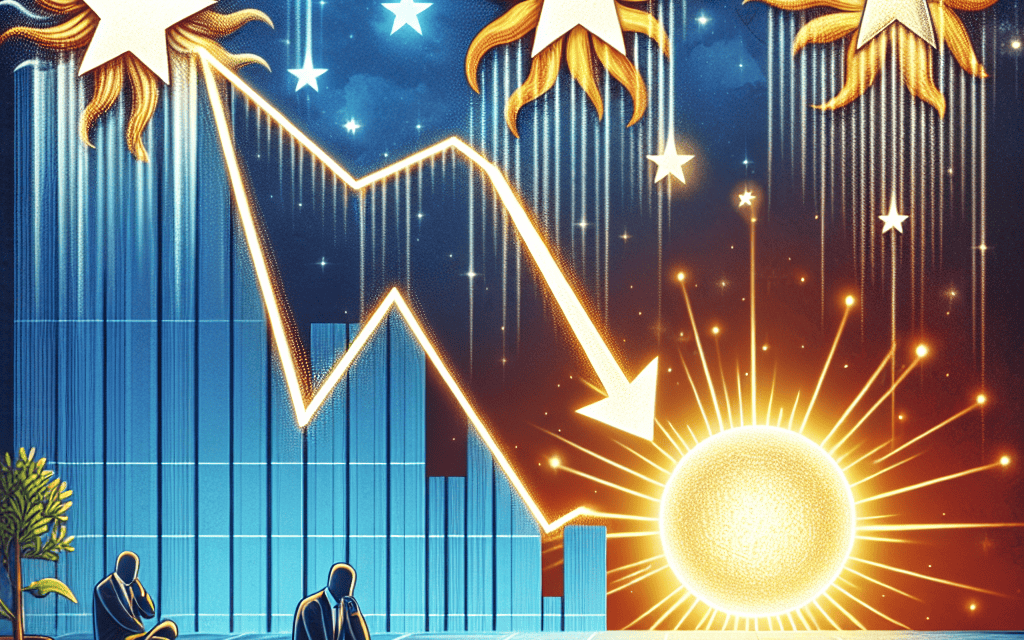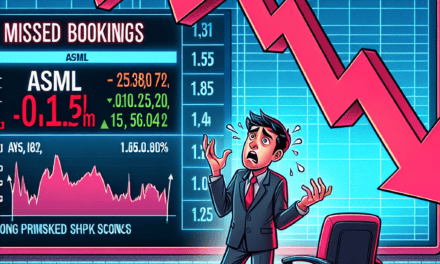“Solar Shock: Enphase Earnings Dive Sends Ripples Through Sunrun and SolarEdge”
Introduction
Enphase Energy, a prominent player in the solar technology sector, recently experienced a significant decline in its stock value following the release of its latest earnings report. The disappointing financial results not only impacted Enphase but also sent ripples through the broader solar industry, affecting other major companies such as Sunrun and SolarEdge. Investors reacted swiftly to the earnings miss, leading to a sharp sell-off that underscored the market’s sensitivity to performance metrics in the renewable energy sector. This downturn highlights the challenges and volatility faced by solar companies amid fluctuating market conditions and evolving industry dynamics.
Enphase Stock Decline: Analyzing the Post-Earnings Impact
Enphase Energy, a prominent player in the solar energy sector, recently experienced a significant decline in its stock value following the release of its latest earnings report. This downturn has not only affected Enphase but has also had a ripple effect on other companies within the solar industry, notably Sunrun and SolarEdge. The post-earnings impact on Enphase’s stock can be attributed to several factors, including market expectations, financial performance, and broader industry trends.
To begin with, Enphase’s earnings report revealed figures that fell short of market expectations, leading to a swift and pronounced reaction from investors. Despite reporting revenue growth, the company’s profit margins were narrower than anticipated, raising concerns about its ability to maintain profitability in a competitive market. This discrepancy between expected and actual performance often triggers a sell-off, as investors reassess the company’s future prospects. Consequently, Enphase’s stock plummeted, reflecting the market’s disappointment and uncertainty.
Moreover, the solar industry as a whole is currently navigating a complex landscape characterized by fluctuating demand, regulatory changes, and evolving technological advancements. Enphase, like its peers, is subject to these external pressures, which can significantly impact its financial health. For instance, changes in government policies regarding renewable energy incentives can alter the demand dynamics for solar products, affecting sales and revenue projections. Additionally, the increasing competition from both established companies and new entrants in the solar market intensifies the pressure on Enphase to innovate and maintain its market share.
Furthermore, the decline in Enphase’s stock has had a cascading effect on other solar companies, such as Sunrun and SolarEdge. Investors often view companies within the same industry as interconnected, meaning that negative news about one can lead to a broader sell-off. Sunrun and SolarEdge, both key players in the solar sector, experienced declines in their stock prices as investors grew wary of potential similar challenges facing these companies. This phenomenon underscores the interconnectedness of the solar industry and highlights the importance of investor sentiment in shaping stock performance.
In addition to these industry-specific factors, broader economic conditions also play a crucial role in influencing stock prices. Rising interest rates, inflationary pressures, and global supply chain disruptions are macroeconomic factors that can affect the solar industry. Higher interest rates, for example, can increase the cost of financing for solar projects, potentially dampening demand. Similarly, supply chain disruptions can lead to delays and increased costs for solar companies, impacting their profitability and stock performance.
In conclusion, the recent decline in Enphase’s stock following its earnings report serves as a reminder of the multifaceted challenges facing the solar industry. While the company’s financial performance and market expectations were immediate triggers for the stock’s decline, broader industry trends and macroeconomic factors also play a significant role. The subsequent impact on Sunrun and SolarEdge further illustrates the interconnected nature of the solar sector and the influence of investor sentiment. As the industry continues to evolve, companies like Enphase must navigate these challenges while striving to capitalize on the growing demand for renewable energy solutions.
Sunrun and SolarEdge: Collateral Damage from Enphase’s Earnings
In the wake of Enphase Energy’s recent earnings report, the solar energy sector has experienced significant turbulence, with Sunrun and SolarEdge feeling the ripple effects. Enphase, a leading provider of solar microinverters, reported earnings that fell short of market expectations, leading to a sharp decline in its stock price. This downturn has not only impacted Enphase but has also sent shockwaves through the broader solar industry, affecting other major players like Sunrun and SolarEdge.
The disappointing earnings report from Enphase highlighted several challenges facing the company, including supply chain disruptions and increased competition. These factors have contributed to a decrease in profit margins, raising concerns among investors about the company’s future growth prospects. As a result, Enphase’s stock plummeted, erasing a significant portion of its market value. This decline has been particularly concerning for investors who had high hopes for the solar sector, given its potential for long-term growth amid the global push for renewable energy.
The impact of Enphase’s earnings miss has not been confined to the company alone. Sunrun, the largest residential solar company in the United States, and SolarEdge, a key player in the solar inverter market, have also seen their stock prices decline in response. This phenomenon can be attributed to the interconnected nature of the solar industry, where the performance of one major company can influence investor sentiment across the sector. As Enphase’s stock tumbled, investors grew wary of potential similar challenges facing Sunrun and SolarEdge, leading to a sell-off in their shares as well.
Moreover, the broader market dynamics have exacerbated the situation. The solar industry is currently navigating a complex landscape characterized by fluctuating raw material costs, regulatory uncertainties, and evolving consumer preferences. These factors have created an environment where any negative news can trigger heightened volatility. Consequently, the disappointing performance of Enphase has acted as a catalyst, amplifying existing concerns and prompting investors to reassess their positions in solar stocks.
Despite the immediate negative impact on Sunrun and SolarEdge, it is essential to consider the long-term outlook for the solar industry. The transition to renewable energy sources remains a critical global priority, driven by the need to combat climate change and reduce reliance on fossil fuels. Governments worldwide are implementing policies and incentives to promote solar energy adoption, which bodes well for the industry’s future growth. While short-term challenges may persist, the underlying fundamentals of the solar sector remain strong, offering potential opportunities for companies that can navigate the current headwinds.
In conclusion, the recent earnings report from Enphase Energy has had a significant impact on the solar industry, with Sunrun and SolarEdge experiencing collateral damage. The interconnected nature of the sector, coupled with broader market dynamics, has contributed to the decline in their stock prices. However, it is crucial to maintain a long-term perspective when evaluating the solar industry’s prospects. Despite the current challenges, the global shift towards renewable energy continues to present opportunities for growth and innovation. As the industry adapts to changing conditions, companies like Sunrun and SolarEdge may find ways to overcome these obstacles and capitalize on the increasing demand for clean energy solutions.
Market Reactions: How Enphase’s Earnings Affected Solar Stocks
In the wake of Enphase Energy’s recent earnings report, the solar energy sector has experienced significant market turbulence, with Enphase’s stock taking a notable hit and subsequently impacting other major players like Sunrun and SolarEdge. This downturn has raised questions about the broader implications for the solar industry, as investors reassess their positions in light of the latest financial disclosures. Enphase Energy, a leading provider of solar microinverters, reported earnings that fell short of market expectations, triggering a sharp decline in its stock price. The company’s revenue growth, while still positive, did not meet the optimistic forecasts set by analysts, leading to a reevaluation of its market valuation. This shortfall was attributed to a combination of factors, including supply chain disruptions and fluctuating demand in key markets. As a result, Enphase’s stock plummeted, sending ripples across the solar sector.
The impact of Enphase’s earnings miss was not confined to its own stock. Sunrun, another prominent player in the solar industry, also saw its shares decline in response to the news. Investors, wary of potential contagion effects, began to question whether Sunrun might face similar challenges in its operations. Although Sunrun’s business model differs from Enphase’s, the interconnected nature of the solar market means that negative sentiment can easily spread, affecting companies with even tangential relationships. Furthermore, SolarEdge Technologies, a competitor of Enphase, experienced a similar downturn in its stock price. Despite SolarEdge’s distinct product offerings and market strategies, the company’s shares were not immune to the broader market reaction. This decline underscores the sensitivity of solar stocks to industry-wide developments, as investors often react to perceived risks that could impact the sector as a whole.
In addition to these immediate market reactions, the earnings report has prompted a broader discussion about the future of the solar industry. While the sector has enjoyed substantial growth in recent years, driven by increasing demand for renewable energy and supportive government policies, challenges remain. Supply chain issues, fluctuating raw material costs, and evolving regulatory landscapes continue to pose risks to solar companies. Consequently, investors are now more cautious, seeking to understand how these factors might influence future earnings and growth prospects. Moreover, the recent market volatility highlights the importance of diversification within investment portfolios. For those heavily invested in solar stocks, the downturn serves as a reminder of the inherent risks associated with sector-specific investments. Diversification across different industries and asset classes can help mitigate such risks, providing a buffer against unexpected market movements.
Looking ahead, the solar industry remains poised for long-term growth, driven by the global transition towards cleaner energy sources. However, companies within the sector must navigate a complex landscape, balancing innovation and expansion with operational challenges. As Enphase, Sunrun, and SolarEdge work to address these issues, investors will be closely monitoring their strategies and performance in upcoming quarters. In conclusion, Enphase Energy’s recent earnings report has had a pronounced impact on the solar market, affecting not only its own stock but also those of Sunrun and SolarEdge. This development underscores the interconnectedness of the solar industry and the importance of careful analysis and diversification for investors. As the sector continues to evolve, market participants will need to remain vigilant, adapting to changing conditions while capitalizing on the opportunities presented by the ongoing shift towards renewable energy.
Investor Sentiment: Understanding the Plunge in Solar Stocks

In the wake of Enphase Energy’s recent earnings report, the solar industry has witnessed a significant shift in investor sentiment, leading to a notable decline in the stock prices of not only Enphase but also its peers, Sunrun and SolarEdge. This downturn has sparked discussions among investors and analysts alike, as they seek to understand the underlying factors contributing to this sudden plunge in solar stocks. Enphase Energy, a prominent player in the solar technology sector, reported earnings that fell short of market expectations. Despite the company’s efforts to expand its product offerings and enhance its technological capabilities, the financial results revealed challenges that have raised concerns about the broader solar market’s trajectory. The earnings report highlighted issues such as supply chain disruptions and increased production costs, which have adversely impacted profit margins. Consequently, these factors have led to a reassessment of the company’s growth prospects, prompting a sell-off in its stock.
As Enphase’s stock tumbled, the ripple effect was felt across the solar industry, with Sunrun and SolarEdge experiencing similar declines. This interconnectedness among solar companies is not uncommon, as investors often view the sector as a collective entity, where the performance of one company can influence perceptions of others. Sunrun, a leading residential solar provider, and SolarEdge, known for its innovative inverter solutions, both saw their stock prices dip in response to Enphase’s disappointing earnings. This reaction underscores the sensitivity of the solar market to individual company performances and the broader economic environment.
Moreover, the decline in solar stocks can be attributed to broader market dynamics, including fluctuating energy prices and evolving regulatory landscapes. The solar industry, while positioned as a key player in the transition to renewable energy, is not immune to external pressures. For instance, changes in government policies or shifts in energy demand can significantly impact the financial health of solar companies. Investors, therefore, remain vigilant, closely monitoring these external factors that could influence the industry’s future.
In addition to these external pressures, the solar sector faces internal challenges that have contributed to the recent stock declines. Technological advancements, while essential for growth, require substantial investment and can strain financial resources. Companies like Enphase, Sunrun, and SolarEdge are continuously innovating to maintain their competitive edge, but this innovation comes at a cost. Balancing the need for technological advancement with financial stability is a delicate act that solar companies must navigate carefully.
Despite the current downturn, it is important to recognize the long-term potential of the solar industry. The global push towards sustainable energy solutions remains a driving force for growth, and solar companies are well-positioned to capitalize on this trend. However, the path forward is not without obstacles. Companies must address supply chain challenges, manage production costs, and adapt to changing market conditions to ensure sustained growth and investor confidence.
In conclusion, the recent plunge in solar stocks, triggered by Enphase Energy’s earnings report, highlights the complex interplay of factors influencing investor sentiment in the solar industry. While short-term challenges persist, the long-term outlook for solar energy remains promising. Investors and industry stakeholders must remain vigilant, adapting to both internal and external pressures, to navigate the evolving landscape of renewable energy. As the world continues its transition towards cleaner energy sources, the solar sector’s resilience and adaptability will be crucial in shaping its future trajectory.
Enphase Earnings Report: Key Takeaways for Investors
Enphase Energy, a prominent player in the solar energy sector, recently released its earnings report, which has sent ripples through the market, affecting not only its own stock but also those of its competitors, including Sunrun and SolarEdge. The report revealed a mixed bag of results, with some aspects meeting expectations while others fell short, leading to a significant decline in Enphase’s stock price. This downturn has, in turn, impacted the broader solar industry, highlighting the interconnected nature of these companies within the renewable energy market.
To begin with, Enphase’s earnings report showed that the company experienced a decline in revenue compared to previous quarters. This decrease was primarily attributed to supply chain disruptions and increased competition in the solar energy market. Despite these challenges, Enphase managed to maintain a relatively stable profit margin, thanks to its cost-cutting measures and strategic investments in technology. However, the revenue shortfall was enough to unsettle investors, leading to a sharp drop in the company’s stock price.
Moreover, the report highlighted that Enphase is facing increased pressure from competitors, particularly in the microinverter segment, where it has traditionally held a strong position. Companies like SolarEdge are aggressively expanding their market share, offering innovative solutions that appeal to a broader customer base. This heightened competition has forced Enphase to rethink its strategies and focus on enhancing its product offerings to maintain its competitive edge. Consequently, investors are closely monitoring how Enphase plans to navigate this challenging landscape.
In addition to competitive pressures, Enphase’s earnings report also pointed to ongoing supply chain issues that have plagued the solar industry as a whole. The global shortage of semiconductors and other critical components has hampered production capabilities, leading to delays in project completions and increased costs. Enphase, like many other companies in the sector, is working diligently to mitigate these challenges by diversifying its supplier base and investing in supply chain resilience. However, these efforts will take time to bear fruit, and the immediate impact on the company’s financial performance is evident.
The ripple effect of Enphase’s earnings report was felt across the solar industry, with Sunrun and SolarEdge also experiencing declines in their stock prices. Investors, wary of the broader implications of Enphase’s challenges, have become more cautious about the sector’s short-term prospects. Sunrun, a leading residential solar provider, and SolarEdge, a key player in power optimizers and inverters, are both facing similar supply chain and competitive pressures. As a result, their stock prices have mirrored the downward trend seen with Enphase, reflecting investor concerns about the industry’s ability to overcome these hurdles.
Despite the current challenges, the long-term outlook for the solar industry remains positive. The global push towards renewable energy and the increasing adoption of solar technology continue to drive growth opportunities for companies like Enphase, Sunrun, and SolarEdge. However, in the short term, these companies must address the immediate issues of supply chain disruptions and intensifying competition to reassure investors and stabilize their stock prices.
In conclusion, Enphase’s recent earnings report has underscored the challenges facing the solar industry, with its stock plummet serving as a stark reminder of the sector’s volatility. As Enphase, Sunrun, and SolarEdge navigate these turbulent waters, investors will be keenly observing their strategies and responses to ensure they remain viable players in the rapidly evolving renewable energy landscape.
Solar Industry Volatility: Lessons from Enphase’s Stock Drop
The recent downturn in Enphase Energy’s stock following its earnings report has sent ripples through the solar industry, affecting not only its own valuation but also impacting other major players like Sunrun and SolarEdge. This event underscores the inherent volatility within the solar sector, a market that is both promising and unpredictable. As investors and industry stakeholders analyze the implications of this stock drop, it is crucial to understand the broader lessons it imparts about the solar industry’s dynamics.
Enphase Energy, a leading provider of solar microinverters, recently reported earnings that fell short of market expectations. Despite the company’s efforts to expand its product offerings and increase its market share, the financial results highlighted challenges such as supply chain disruptions and fluctuating demand. These factors contributed to a significant decline in Enphase’s stock price, which in turn, had a domino effect on other solar companies. Sunrun, a prominent residential solar installer, and SolarEdge, a key competitor in the inverter market, both experienced declines in their stock prices as investors reassessed the sector’s short-term prospects.
This incident highlights the interconnected nature of the solar industry, where the performance of one company can influence the perception and valuation of others. The solar market is characterized by rapid technological advancements, regulatory changes, and shifting consumer preferences, all of which contribute to its volatility. As such, investors must remain vigilant and adaptable, recognizing that the industry’s growth trajectory is not always linear.
Moreover, the stock drop serves as a reminder of the external factors that can impact the solar industry. Supply chain issues, for instance, have been a persistent challenge, exacerbated by global events such as the COVID-19 pandemic and geopolitical tensions. These disruptions can lead to increased costs and delays in project implementation, affecting companies’ financial performance and investor confidence. Additionally, changes in government policies and incentives can significantly influence the industry’s growth, as seen in various countries where solar subsidies have been reduced or eliminated.
Despite these challenges, the long-term outlook for the solar industry remains positive. The global push towards renewable energy and the increasing emphasis on sustainability continue to drive demand for solar solutions. Technological innovations, such as improved energy storage systems and more efficient solar panels, are expected to enhance the viability and attractiveness of solar energy. Consequently, while short-term fluctuations are inevitable, the industry’s fundamentals suggest a promising future.
In light of Enphase’s recent stock drop, industry participants and investors should consider adopting a more strategic approach. Diversification within the renewable energy sector can mitigate risks associated with individual company performance. Additionally, staying informed about technological advancements and regulatory developments can provide valuable insights into potential opportunities and challenges.
Ultimately, the recent events surrounding Enphase Energy’s stock serve as a microcosm of the solar industry’s broader volatility. While the path to a sustainable energy future is fraught with uncertainties, it is also filled with opportunities for those who are prepared to navigate its complexities. By learning from these fluctuations and adapting to the ever-changing landscape, stakeholders can position themselves to capitalize on the solar industry’s long-term growth potential.
Future Outlook: Can Solar Stocks Recover After Enphase’s Decline?
The recent downturn in Enphase Energy’s stock following its earnings report has sent ripples through the solar industry, raising concerns about the future trajectory of solar stocks. Enphase, a leading provider of solar microinverters, reported earnings that fell short of market expectations, triggering a sharp decline in its stock price. This decline has not only affected Enphase but has also dragged down other prominent solar companies, including Sunrun and SolarEdge, as investors reassess the sector’s prospects. The question now arises: can solar stocks recover from this setback, and what does the future hold for the industry?
To understand the potential for recovery, it is essential to examine the factors contributing to the current decline. Enphase’s disappointing earnings were primarily attributed to supply chain disruptions and increased costs, which have been pervasive issues across various industries. These challenges have led to delays in project completions and increased expenses, squeezing profit margins. Moreover, the broader economic environment, characterized by rising interest rates and inflationary pressures, has further complicated the landscape for solar companies. As a result, investors have become more cautious, leading to a sell-off in solar stocks.
Despite these challenges, the long-term outlook for the solar industry remains promising. The global push towards renewable energy, driven by concerns over climate change and the need for sustainable energy sources, continues to provide a strong foundation for growth. Governments worldwide are implementing policies and incentives to promote solar energy adoption, which is expected to drive demand in the coming years. Additionally, technological advancements in solar panel efficiency and energy storage solutions are likely to enhance the competitiveness of solar power, making it an increasingly attractive option for consumers and businesses alike.
In the short term, however, solar companies must navigate the current headwinds to regain investor confidence. This will require addressing supply chain issues and managing costs effectively to protect profit margins. Companies that can demonstrate resilience and adaptability in the face of these challenges are likely to emerge stronger and better positioned for future growth. Furthermore, strategic partnerships and collaborations within the industry could help mitigate some of the risks associated with supply chain disruptions, providing a pathway to recovery.
Investors, on the other hand, may need to adopt a more discerning approach when evaluating solar stocks. While the sector’s long-term potential remains intact, not all companies will be equally equipped to capitalize on the opportunities ahead. Identifying firms with robust financial health, innovative technologies, and strong management teams will be crucial in navigating the current volatility and positioning for future gains.
In conclusion, while Enphase’s recent stock decline has cast a shadow over the solar industry, the sector’s long-term prospects remain bright. The transition to renewable energy is an irreversible trend, and solar power is poised to play a pivotal role in this transformation. However, the path to recovery will require overcoming immediate challenges and demonstrating resilience in the face of adversity. As the industry adapts and evolves, solar stocks have the potential to rebound, offering investors opportunities for growth in the years to come.
Q&A
1. **What caused Enphase stock to plummet post-earnings?**
Enphase stock plummeted due to disappointing earnings results, which included lower-than-expected revenue and guidance.
2. **How did Enphase’s earnings report affect its stock price?**
The earnings report led to a significant drop in Enphase’s stock price as investors reacted negatively to the financial performance and future outlook.
3. **Which other solar companies were affected by Enphase’s stock decline?**
Sunrun and SolarEdge were also affected, experiencing declines in their stock prices as the negative sentiment spread across the solar sector.
4. **What specific financial metrics in Enphase’s report were concerning to investors?**
Investors were concerned about Enphase’s lower-than-expected revenue figures and reduced guidance for future quarters.
5. **How did the market react to the overall solar sector following Enphase’s earnings?**
The market reacted with a sell-off in the solar sector, as Enphase’s disappointing results raised concerns about broader industry challenges.
6. **What external factors might have contributed to the decline in solar stocks?**
External factors such as rising interest rates, supply chain issues, and changes in government policies could have contributed to the decline in solar stocks.
7. **What are analysts saying about the future of Enphase and the solar industry?**
Analysts have mixed views, with some expressing caution due to current challenges, while others remain optimistic about long-term growth prospects in the solar industry.
Conclusion
Enphase Energy’s stock experienced a significant decline following its earnings report, which had a ripple effect on the broader solar sector, notably impacting Sunrun and SolarEdge. The drop in Enphase’s stock can be attributed to factors such as disappointing financial results, lowered guidance, or broader market conditions affecting investor sentiment. This decline suggests potential concerns about growth prospects or profitability within the solar industry, leading to a loss of investor confidence. Consequently, the negative performance of Enphase has exerted downward pressure on related stocks like Sunrun and SolarEdge, highlighting the interconnectedness of companies within the renewable energy sector and the sensitivity of their stock prices to industry-specific developments.





